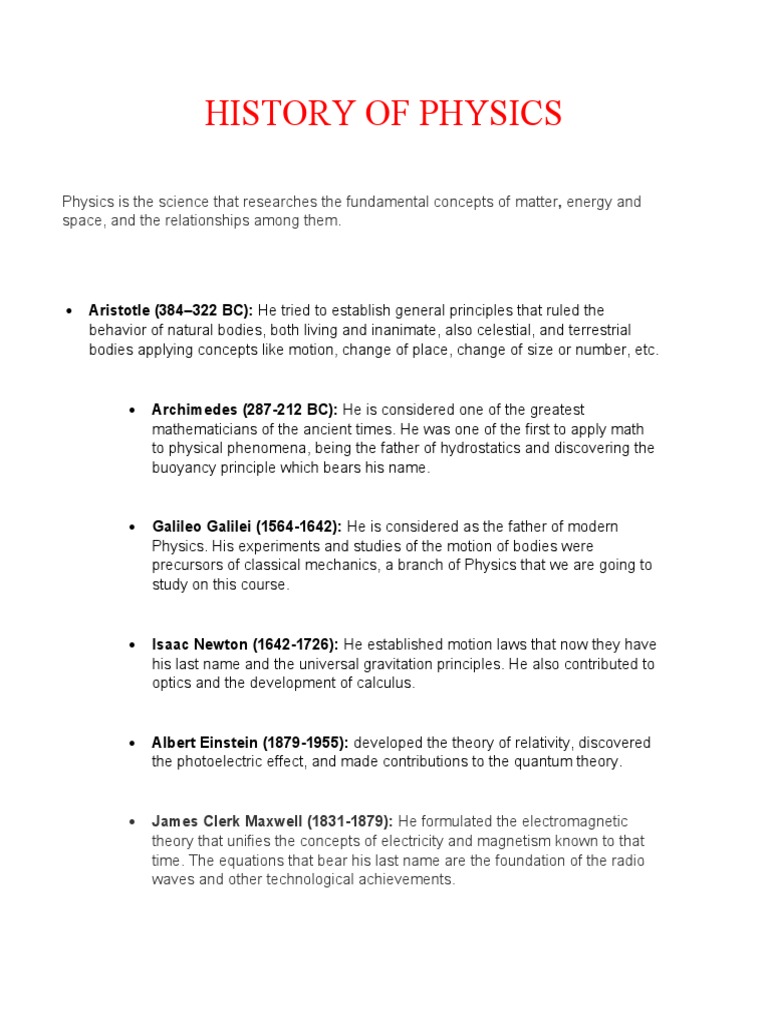The evolution of physics over the centuries has been a remarkable journey, reflecting humanity’s enduring quest to comprehend the underlying principles of the universe. From antiquity to modern times, physics has undergone profound transformations, both in its methodologies and its theoretical constructs. This article delves into the historical progression of physics, examining critical milestones that have shaped its contemporary landscape, and illuminating the diverse forms of content that elucidate these advancements.
In ancient times, the frameworks of physics were rudimentary, often intertwined with philosophy and metaphysics. The pre-Socratic philosophers, notably Thales and Anaximander, postulated natural explanations for phenomena rather than ascribing them solely to divine intervention. Their inquisitiveness heralded the birth of natural philosophy, a precursor to modern scientific inquiry. Notably, Aristotle’s extensive work in the 4th century BCE systematically categorized knowledge and laid the groundwork for later physics through the observation of nature and the application of logical reasoning.
The onset of the Scientific Revolution in the 16th and 17th centuries marked a pivotal shift in the discipline, characterized by a methodological approach grounded in empirical observation and experimentation. Figures such as Galileo Galilei employed the scientific method, challenging Aristotelian physics with empirical data on motion and kinematics. Galileo’s heretical advocacy for heliocentrism, alongside Johannes Kepler’s laws of planetary motion, dismantled the geocentric perspective and established a new cosmological paradigm, leading to a reorientation in the understanding of celestial mechanics.
Isaac Newton’s magnum opus, the “Philosophiæ Naturalis Principia Mathematica,” published in 1687, synthesized the advancements of his predecessors, culminating in a comprehensive mathematical description of motion and gravitation. Newton’s laws of motion and universal gravitation introduced a deterministic framework, which reigned supreme in classical physics for more than two centuries. This era heralded significant economic and technological developments, as the principles of physics underpinned innovations in engineering, astronomy, and navigation.
As physics progressed into the 19th century, classical mechanics evolved, accommodating the burgeoning knowledge of heat and thermodynamics. The industrial revolution catalyzed new inquiries into energy transformation and thermal dynamics. The formulation of the laws of thermodynamics by scientists such as Sadi Carnot and Rudolf Clausius elucidated the principles governing energy exchanges, cementing the concept of energy conservation. This era not only advanced scientific thought but also reshaped industries and lifestyles, laying the groundwork for contemporary technological society.
The transition from classical to modern physics occurred in the early 20th century, spurred by the revolutionary theories of relativity and quantum mechanics. Albert Einstein’s theory of special relativity, articulated in 1905, dismantled the Newtonian notion of absolute time and space, proposing instead that these dimensions are relative and intertwined. His general theory of relativity, published in 1915, further transformed the understanding of gravity as a curvature of spacetime rather than a force acting at a distance. This profound conceptual shift necessitated a reevaluation of the cosmos and the very fabric of reality.
Simultaneously, the development of quantum mechanics unraveled the complexities of atomic and subatomic behavior. This paradigm shift was underscored by Max Planck’s quantum hypothesis in 1900, and subsequently expanded through the works of Niels Bohr, Werner Heisenberg, and Erwin Schrödinger. The principles governing wave-particle duality, superposition, and entanglement introduced a level of abstraction and probabilistic interpretation previously absent in classical physics, challenging the deterministic worldview and fostering philosophical implications that reverberate through modern discourse.
Throughout the 20th century, experimental advancements propelled physics into realms previously considered speculative. The discovery of the electron, the development of the Standard Model, and the exploration of nuclear physics highlighted the intricate tapestry of the microcosm. Notable experiments, including those conducted at CERN, elucidated the fundamental particles and forces underpinning the universe, honing a deeper understanding of the interactions shaping the cosmos. The insights gained from particle physics have been instrumental in elucidating phenomena ranging from the Higgs boson to the early moments of the Big Bang.
In contemporary discourse, physics continues to evolve, grappling with the interplay between established theories and emergent concepts. The investigation of dark matter and dark energy, along with the quest for a unified theory of quantum gravity, illustrates the field’s ongoing dynamism. Interdisciplinary collaboration with fields such as astrophysics, biophysics, and information technology has fostered innovative perspectives and methodologies, broadening the horizons of inquiry.
The dissemination of knowledge has also transformed in the digital age, with significant implications for how content pertaining to physics is consumed and rendered accessible. Academic journals, popular science literature, podcasts, and online courses cultivate diverse content aimed at varied audiences. These platforms facilitate the dissemination of groundbreaking research while nurturing public engagement with scientific concepts. Enhanced graphic representations, educational simulations, and interactive media provide novel avenues for understanding complex phenomena, effectively bridging gaps between experts and laypersons.
In conclusion, the internal dynamics of physics reflect a rich tapestry woven through centuries of inquiry, characterized by transformative moments and revolutionary theories. The trajectory from ancient philosophies to contemporary quantum mechanics exemplifies humanity’s relentless pursuit of understanding the natural world. As the discipline continues to evolve, the synthesis of historical insights and modern inquiries promises to forge new paths in the exploration of the universe, enriching the fabric of scientific knowledge and broadening the horizons of future generations.












